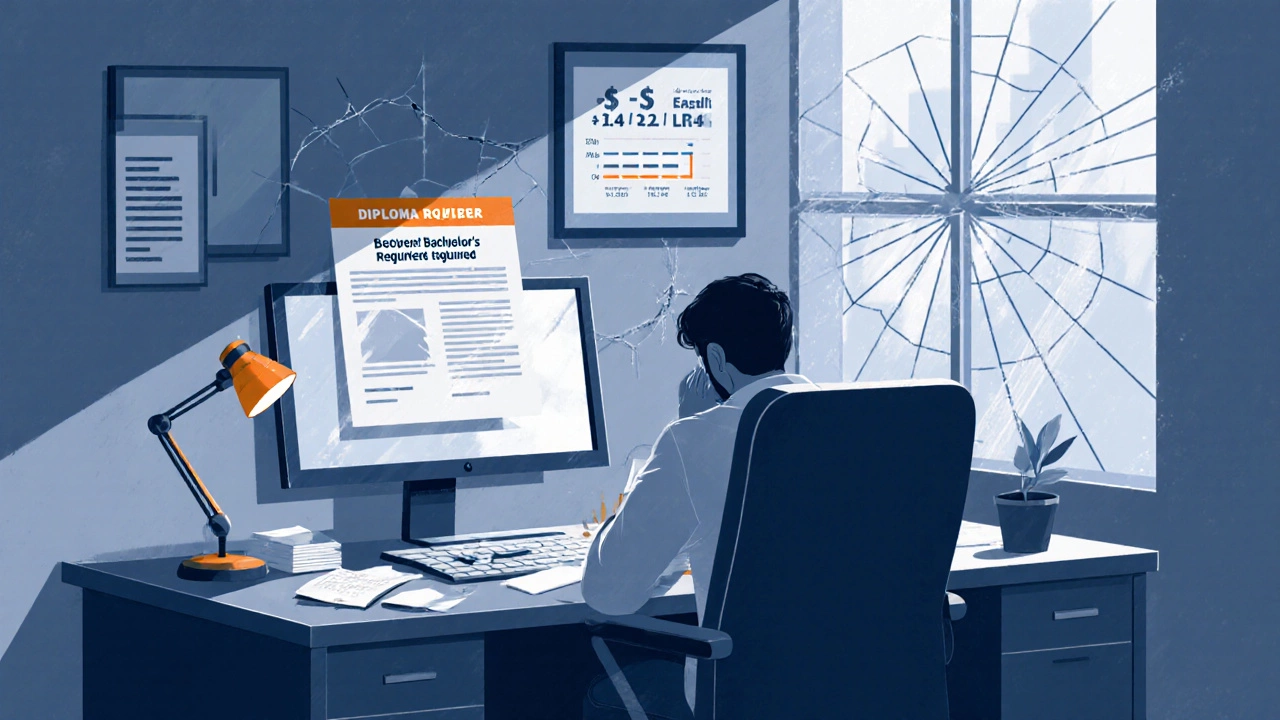Diploma Disadvantages: What You Need to Know
 Oct, 15 2025
Oct, 15 2025
Diploma vs Degree Salary Calculator
Salary Comparison Tool
See how earnings differ between diploma and degree holders over time based on Indian market data.
Key Findings
Entry Level
Diploma: ₹2.4-3.2 LPA
Degree: ₹4-5 LPA
Progression Degree holders typically earn 30-40% more after 5+ years due to better promotion opportunities.
Long Term Beyond 10 years, the salary gap widens significantly with degree holders often reaching senior management roles.
Projected Earnings
₹3.1 LPA
₹4.7 LPA
When you’re weighing your options after high school, a diploma program often looks like a quick ticket to a job. But is it really the shortcut it seems? Let’s break down the real downsides so you can decide if a diploma fits your career plans.
What a Diploma is and how it differs from a degree
A Diploma is a short‑term academic credential usually lasting one to two years. It focuses on practical, job‑ready skills rather than deep theory. In contrast, a Bachelor's degree typically takes three to four years, mixes theory with practice, and opens doors to higher‑level positions.
1. Limited Career Growth - Why employers may look past a diploma
Many Indian companies still tie senior roles, management tracks, and overseas assignments to a diploma disadvantages mindset: they value a degree more. A diploma can land you an entry‑level job, but climbing the ladder often stalls because:
- Job postings for mid‑level roles specifically require a bachelor’s degree.
- Salary bands are usually wider for degree holders; you may start at a lower pay grade.
- Professional networks and alumni groups are richer for university graduates.
For example, a 2024 survey by the Indian Association of Technical Institutes found that 62% of hiring managers preferred degree holders for roles beyond junior technician positions.
2. Perceived Lack of Depth - Theory matters too
Diploma curricula prioritize hands‑on training, which is great for immediate tasks but often skips the “why” behind those tasks. This can lead to:
- Difficulty adapting when technology changes.
- Challenges in solving problems that require a broader knowledge base.
- Less credibility when you need to explain concepts to clients or senior staff.
Imagine a telecom technician who knows how to install a router but can’t troubleshoot a new routing protocol because the underlying concepts weren’t covered.
3. Accreditation and Recognition Issues
Not all diploma courses carry the same weight. Some are offered by private training centers with limited accreditation, which can affect:
- Eligibility for government scholarships or loans.
- Recognition by larger employers or overseas institutions.
- Eligibility for further studies, like a master’s program.
The All India Council for Technical Education (AICTE) maintains a list of approved diploma institutes. Picking an unapproved program may leave you with a certificate that few recognize.
4. Lower Employability in Certain Sectors
While diplomas shine in trades like electrician work, automotive repairs, or basic IT support, they lag in fields such as finance, law, or research. In those sectors, a degree is often a baseline requirement.
Data from the National Career Service (NCS) 2023 shows that 48% of finance job openings required a bachelor's degree, while only 15% accepted a diploma.

5. Salary Ceiling - The numbers speak
Entry‑level diploma holders in India earn an average of ₹2.4‑₹3.2 lakh per year, according to a 2024 salary report by Payscale India. Degree holders in similar roles start at ₹4‑₹5 lakh. The gap widens as experience grows, and many high‑paying roles-like senior software engineer or project manager-are off‑limits without a degree.
6. Difficulty Switching Careers
A diploma ties you to a specific skill set. If you later decide to shift to a different industry, you may need to start from scratch or invest in a full degree program. This “lock‑in” effect can be costly both in time and money.
7. Fewer Opportunities for Advanced Studies
Most Indian universities require a bachelor’s degree for master’s programs. Some institutions offer “diploma‑to‑degree” bridges, but they often add extra semesters and extra fees. Without a clear pathway, you may miss out on graduate education altogether.
Comparison: Diploma vs Bachelor’s Degree
| Aspect | Diploma | Bachelor's Degree |
|---|---|---|
| Duration | 1‑2 years | 3‑4 years |
| Focus | Practical skills | Theory + practice |
| Typical Salary (entry) | ₹2.4‑₹3.2LPA | ₹4‑₹5LPA |
| Accreditation | Varies; AICTE‑approved optional | Universally recognized |
| Career Progression | Limited beyond junior roles | Open to senior & managerial roles |
| Eligibility for Masters | Usually not eligible | Eligible |

8. Real‑World Stories - When a Diploma Wasn't Enough
Ravi, a 2022 graduate of a polytechnic diploma in mechanical engineering, landed a job as a junior technician in a Mumbai factory. After two years, he applied for a senior maintenance supervisor role, but the posting required a bachelor's degree. He finally enrolled in an evening B.Tech program, extending his studies by three years while working night shifts. His story highlights the hidden cost of starting with a diploma when you aim for higher positions.
On the flip side, Sneha completed a three‑year diploma in graphic design and quickly secured freelance contracts that paid more than many entry‑level graduate designers. Her niche creativity and strong portfolio trumped the formal degree requirement in the freelance market.
How to Mitigate the Disadvantages
If you’re set on a diploma, there are ways to soften the blow:
- Choose an AICTE‑approved institute to ensure credibility.
- Supplement coursework with online certifications (e.g., Coursera, Udemy) that are recognized internationally.
- Network actively-join industry groups, attend workshops, and seek mentorship.
- Plan a “bridge” degree later if you foresee career growth needs.
- Document your projects and quantify achievements; a strong portfolio can offset a missing degree.
Bottom Line - Is a Diploma Right for You?
There’s no one‑size‑fits‑all answer. If you need to enter the workforce quickly, have a clear trade‑specific goal, and can secure a reputable, accredited program, a diploma can be a solid stepping stone. But if you envision moving into management, research, or sectors that demand higher academic credentials, you should weigh the potential earnings gap, limited advancement, and extra time you might spend later on a degree.
Frequently Asked Questions
Can a diploma holder pursue a master’s degree in India?
Most Indian universities require a bachelor’s degree for master’s admissions. Some institutes offer diploma‑to‑degree bridge programs, but they add extra semesters and fees. Without a bridge, you’ll need to complete a degree first.
Are diploma courses in India accredited?
Accreditation varies. The AICTE maintains a list of approved diploma institutes. Always verify the institute’s status before enrolling to ensure your certificate is recognized by employers and government schemes.
Do diploma holders earn less than degree holders?
On average, yes. Entry‑level diploma graduates earn around ₹2.4‑₹3.2lakh per year, while degree graduates start at ₹4‑₹5lakh. The gap widens with experience and seniority.
Which sectors value diplomas the most?
Technical trades such as automotive repair, electrical work, basic IT support, and some hospitality roles prioritize practical skills, making diplomas highly valuable in those areas.
How can I boost my employability with a diploma?
Add industry‑recognized certifications, build a strong portfolio, network through professional groups, and consider part‑time or distance learning to eventually earn a degree.